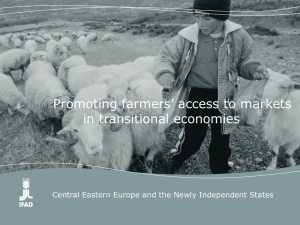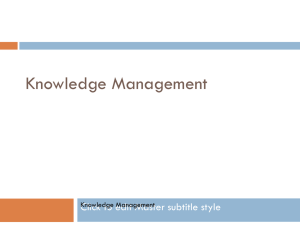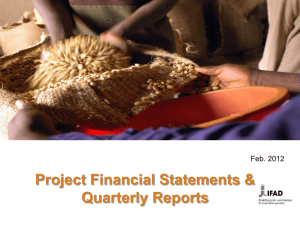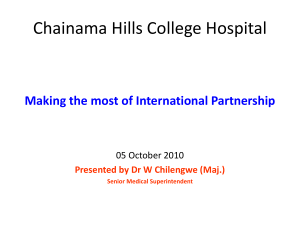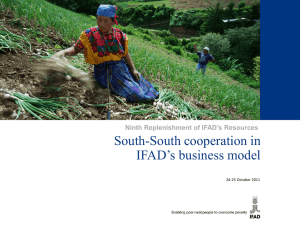IFAD partnership strategy
advertisement
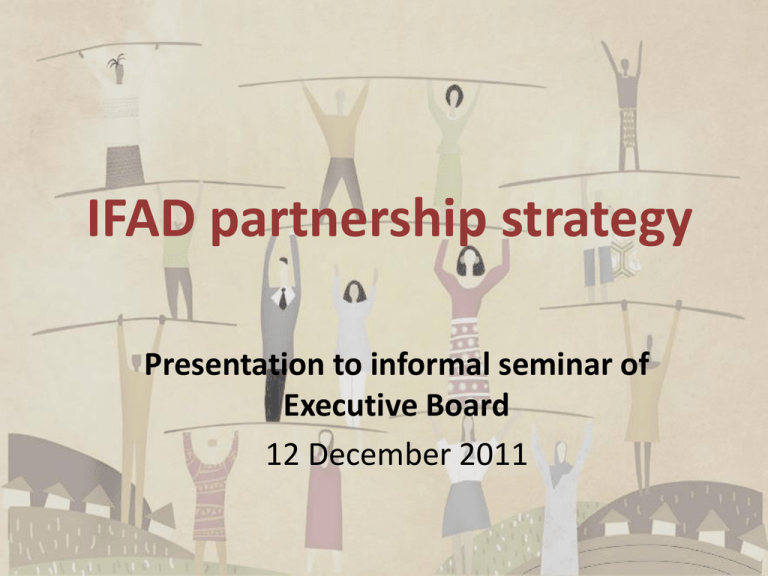
IFAD partnership strategy Presentation to informal seminar of Executive Board 12 December 2011 Background and process • Consultation document of Eighth Replenishment committed IFAD to prepare partnership strategy • Strategic Framework 2011-2015 reconfirmed the importance of partnerships for IFAD’s work – one of its ‘principles of engagement’ • Initial work towards strategy – Information Note to Executive Board Sept. 2011, led from NALO • Policy Reference Group for strategy established Oct. 2011, met twice to date • Interviews with staff and managers; meetings with Resource Mobilisation and Partnerships Office (RMP), with CPM focus group; research and initial consultation with IFAD partners; mapping of IFAD’s existing partnerships; review of key documentation, including IOE work • The Partnering Initiative (TPI) – specialised NGO – supporting the in-house work • Presentation of preliminary ideas to Informal Seminar of Executive Board Dec. 2011 – for discussion and views • Sharing of draft strategy document for comments, and presentation of final version to Executive Board in 2012 Partnerships are integral to IFAD’s work IFAD works with many sorts of partners, in virtually all aspects of its work: • Member governments • • • NGOs / foundations Civil society / farmers’ organizations International organizations (RBAs, other UN, CGIAR) Bilateral/multilateral devt. organizations Policy research institutions/universities Regional organizations Private sector • • • • • • • • • • • • • Resource mobilization, scaling up Programmes and projects Policy dialogue KMI, lesson learning Communications Administrative efficiency Institutional representation/ credibility Partnerships exist at global/corporate, regional and national/local levels Many officialised through MOUs, agreements; but also many less formal IFAD also draws on its experience, reputation and networks to broker partnerships: • • • Between governments and RPOs/ private sector; for south-south learning Growing role in increasingly complex and differentiated world Offers scope to enhance IFAD’s value to governments and other stakeholders So why an IFAD partnership strategy? • A rapidly changing external environment: – Complex development issues require broad or multi-sectoral expertise, and new, knowledge-intensive ways of working – Need for scalable solutions for substantial impact on rural poverty – Evolving Aid Effectiveness agenda – Busan focus on partnerships • In this context, partnerships can enable IFAD to: – Focus on what it is mandated to do and does best – Leverage external resources to complement its own programme of work – Better achieve its strategic objectives • Building on what IFAD already does, a more strategic approach to partnerships can help the organization: – To be more selective, and give focus, direction and guidance to development and management of partnerships – To maximise efficiency and effectiveness of partnerships in achieving its strategic objectives Definition of partnerships Partnerships are defined here as: Collaborative relationships between institutional actors that combine their complementary strengths and resources and work together in a transparent, equitable and mutually beneficial way to achieve a common goal or undertake specific tasks. Partners share the risks, responsibilities, resources and benefits of that collaboration and learn from it through regular monitoring and review. Note: • Partnerships are not an end in themselves; rather a vehicle to achieve a defined objective • Not all relationships are partnerships: – A contract is not a partnership – Collaboration is not necessarily a partnership – Some networks are partnerships, others may not be • The definition includes elements that are useful for prioritising and managing partnerships, less so for classifying them • Some ambiguity will remain as collaborations develop and change Partnership SWOT for IFAD Strengths, Weaknesses, Opportunities & Threats from research interviews, focus groups meetings, views of external partners, and recent ARRI and CLE evaluation data Strengths Weaknesses • High level of co-financing in IFAD country programmes • Lack of common institutional understanding / vision; ad hoc, nonstrategic development of partnerships; and lack of explicit, coherent management of partnerships • Strong partnerships with many member countries – particularly from Lists A and C • Innovative partnerships – e.g. PPPs in Uganda, Sao Tome; Spanish loan • Unique partnerships with Rural Producers’ Organizations – Farmers’ Forum, regional and country levels • Lack of institutional visibility, and inadequate outreach to potential partners (branding, marketing) • Partnerships with member states uneven: e.g. insufficient attention to • With long-term commitment to countries, partnerships for List B / transforming List IFAD trusted as partnership broker by C member countries governments • A limited number of IFAD partnerships • Comparative advantage recognised by perhaps bring limited benefits relative to potential partners – there is interest in their costs partnering with IFAD • Lack of country presence to sustain • Good (and improving) rating from IFAD country-level partnerships partners Opportunities Threats • Learn from past successes and failures • Lack of effective partnerships will limit IFAD’s ability to achieve its strategic objectives • Build a common institutional vision and develop pro-active strategic approach to partnerships • Commitment to strengthening Resource Mobilisation and Partnership Office • Lack of partnership incentives at all levels in some other institutions can make partnering difficult • IFAD unable to show others that it can be a preferred partner for them – requires results to be achieved, ‘IFAD brand’, • Potential to expand partnerships with e.g. partnership approach, as well as the private sector, RBAs, List B/ marketing of all these transforming List C member countries • Competition from other IFIs and • Global concern for agricultural production development agencies and food security • Country offices create new opportunities for partnership development • Evolving Aid Effectiveness agenda leads more RD stakeholders to explore partnering options Lessons from beyond IFAD • Benchmarking of good practices elsewhere – and in particular the approaches and practices of IFIs – will provide lessons and shape IFAD’s strategic approach. • Preliminary lessons from other organizations about harnessing and managing partnerships for strategic impact include the following: – Strategy: Of the main IFI’s (WB and RDBs), only the AfDB has any form of partnership strategy, though this is limited to a statement of objectives. AsDB has a series of documents for specific partnership types. Elsewhere, partnership strategies have been developed by UN agencies (UNICEF) and CGIAR centres (ILRI). – Structure: All main IFIs have an office with responsibilities for formal, financiallybased partnerships and resource mobilization. Most large corporate players have a dedicated partnership unit. – Practice: WHO partnership agreements include a requirement to review the partnership performance, its value to WHO, and continued demand for/alternatives to it. UNESCO’s simple, compelling World Heritage Sites programme has offered strong opportunities for partnerships with governments and private sector. In corporate sector, strong brand management underpins partnership efforts. Rationale and objectives of a strategic approach paper The rationale • • IFAD works with so many different partners, for so many different purposes, that a single organizational strategy may add little value Instead, a strategic approach paper would provide guidance for different types of partnership, yet not seek to impose single partnership model The objective of the strategic approach paper will be to assist IFAD to be more selective in its partnerships, and enable managers and staff to develop and manage partnerships more effectively and efficiently, so as to better achieve IFAD’s overall strategic objectives. It will provide greater clarity about: • • • • • • Why IFAD should enter into specific partnerships What it wants those partnerships to achieve Which organizations to partner with How to develop and manage the partnerships Who in IFAD is responsible for these activities When partnership isn’t the right option Proposed typology of partnerships The strategic approach paper will use the following descriptive typology to aggregate IFAD’s partnerships; activities will be prioritised under each type: Partnership types Examples Levels of partnerships Main partners Programmes and projects (CMR 1-3) Private sector devt., climate change, KMI, nat. level policy dialogue, scaling-up National, regional Member governments, RPOs, NGOs, private sector, development partners, UN agencies Global policy dialogue (CMR 8) Food price volatility, CFS, Global Donor Platform on RD, gender Global, regional International organizations, research organizations, member governments Resource mobilization (CMR 10) Replenishment, Supplementary funds, Spanish loan Global Member governments, foundations Organizational efficiency (CMR 4-7) RBA joint procurement, Corporate UN joint pension plan IFIs, UN agencies Partnership types defined relative to IFAD’s Corporate Management Results, considered critical to achieving IFAD’s overall strategic priorities The paper will also highlight the following: That while there are vastly different sorts of partnerships with a wide variety of partners, under all four partnership types: • Focus needs to be on development impact for rural poverty reduction, as defined in the Strategic Framework 2011-2015 • Scaling-up is a priority: it will be central to expanded impact • Issues of knowledge management and innovation – of learning – are critical • IFAD can offer substantial value added acting as a broker/facilitator of partnerships • There is need to review new and renewed partnerships for their contribution to IFAD objectives, and discontinue those whose costs outweigh the benefits • It is important to strengthen IFAD’s capacity to effectively manage partnerships Strengthening IFAD’s capacity to effectively manage partnerships The strategic approach paper will provide guidance to IFAD on how to effectively manage partnerships, with attention given to the following areas: RESOURCE EXAMPLE Tools/Instruments Develop criteria for partnership assessment and selection (shared objectives, clear agenda, capacity of partner, value for money, etc.) Systems Define e.g. institutional responsibilities for developing, managing, monitoring and reviewing partnerships; the role of RMP; incentives for partnership development Processes Internalise partnerships in business processes, in e.g. project design or HR competencies Training Strengthen skills of key staff in partnership management, partnership brokerage Learning Integrate review and capturing lessons from partnerships, evaluating the strategy Questions to Executive Board members • What partnership experiences can you share that would be helpful to IFAD? • What do you see as the key challenges and opportunities of partnerships for IFAD? • Is the proposal to develop a strategic approach paper an appropriate one? • What do you see as its key elements?


